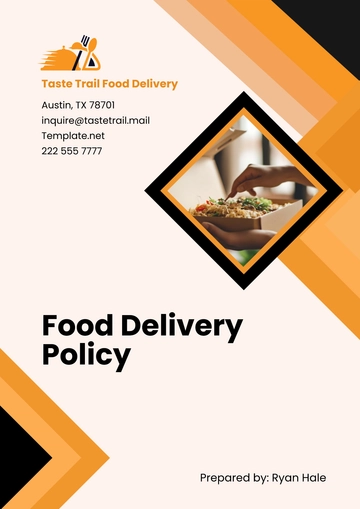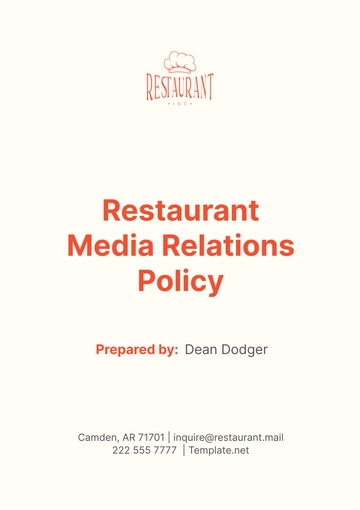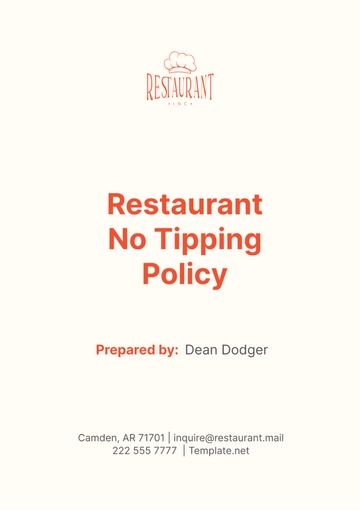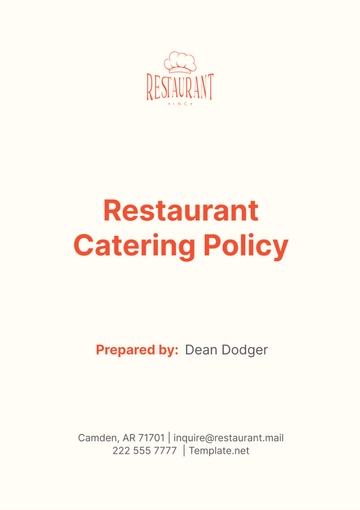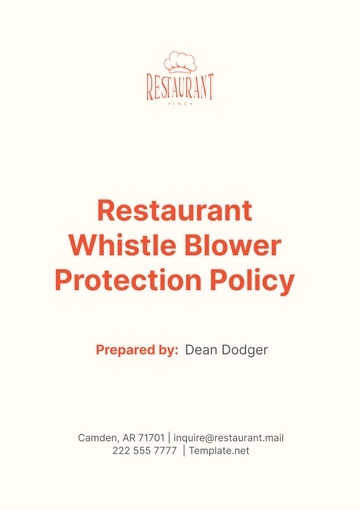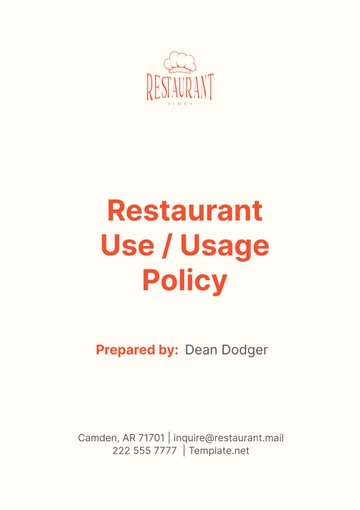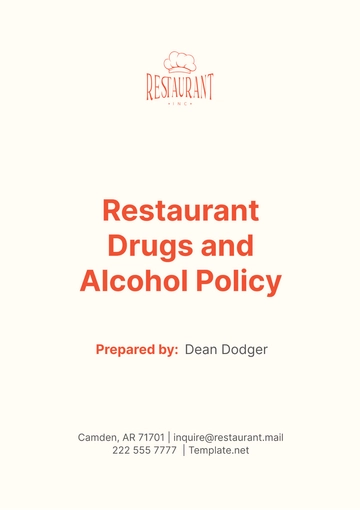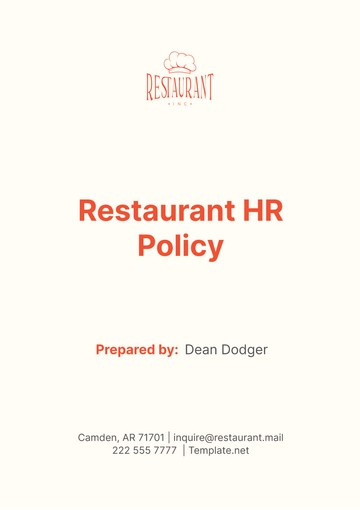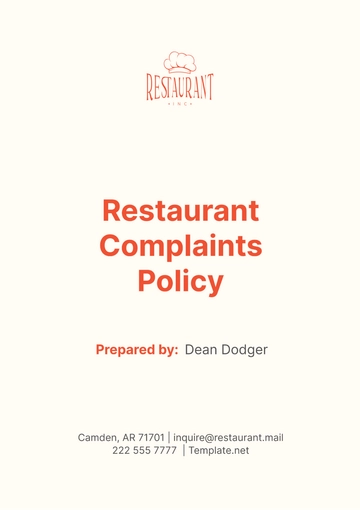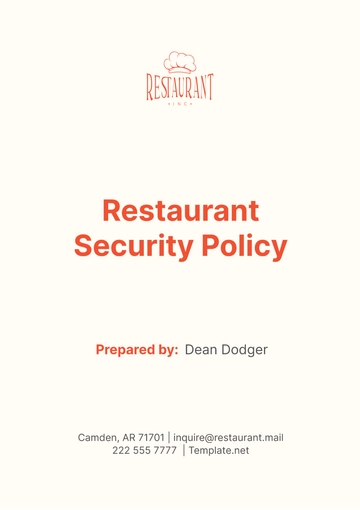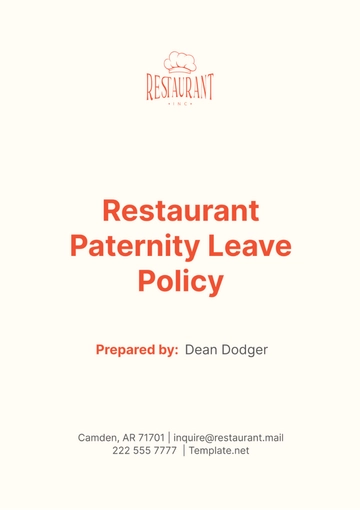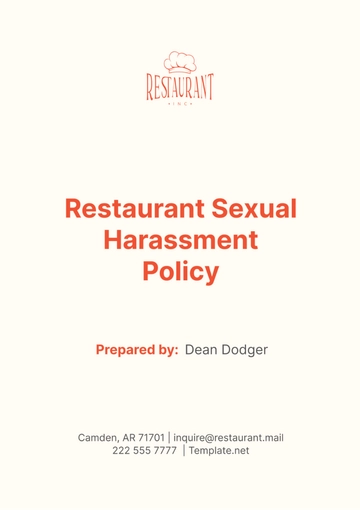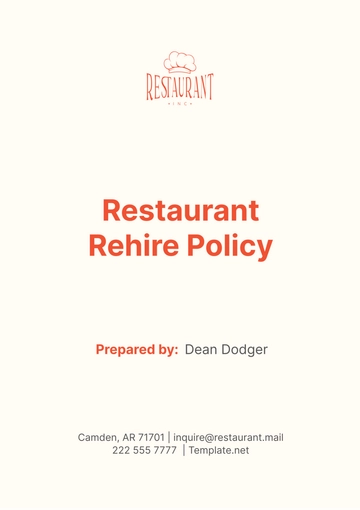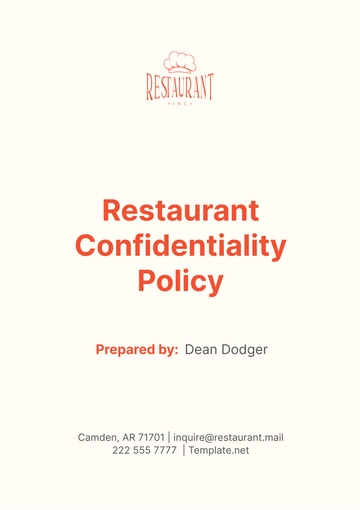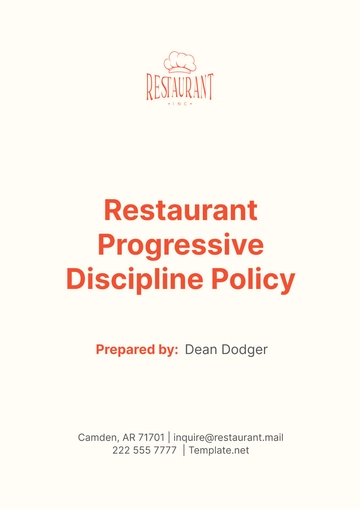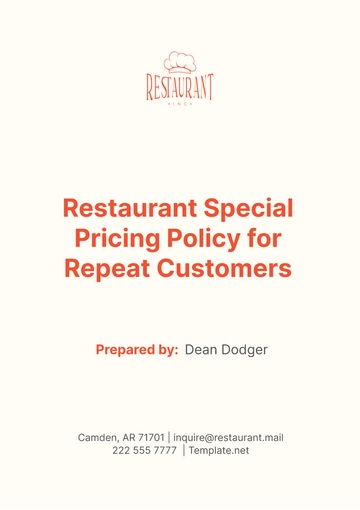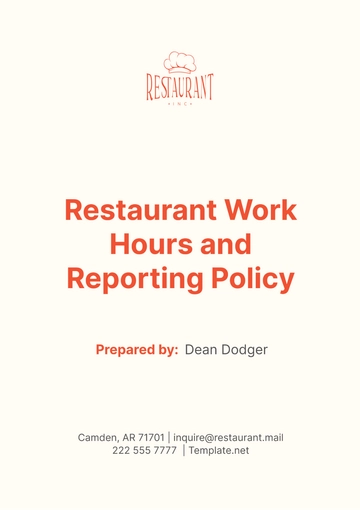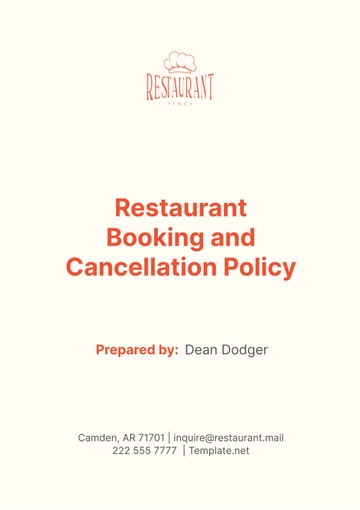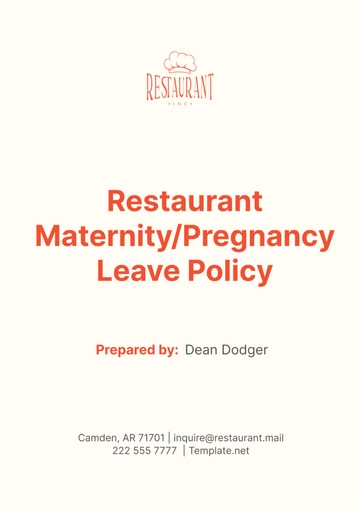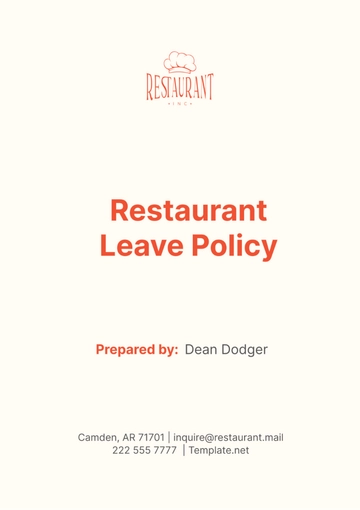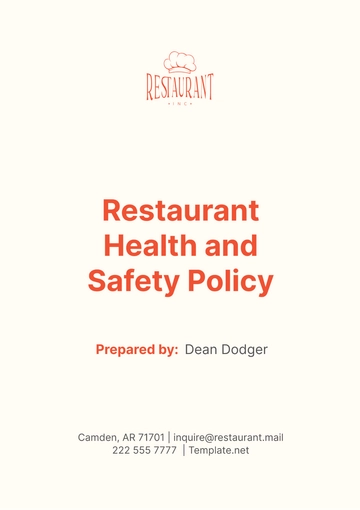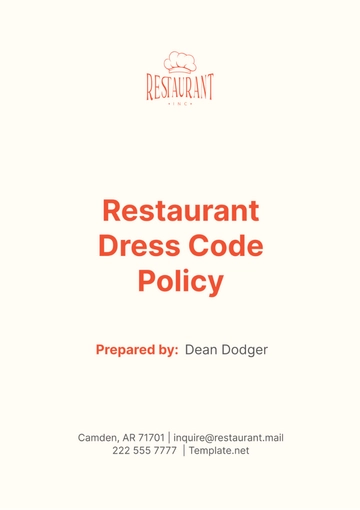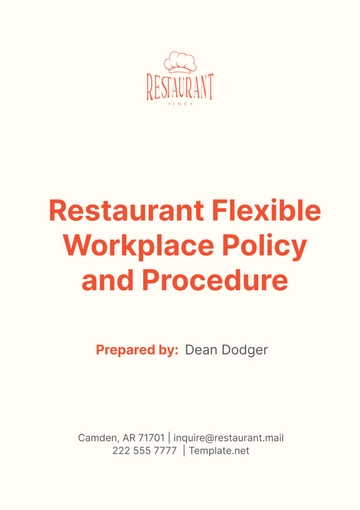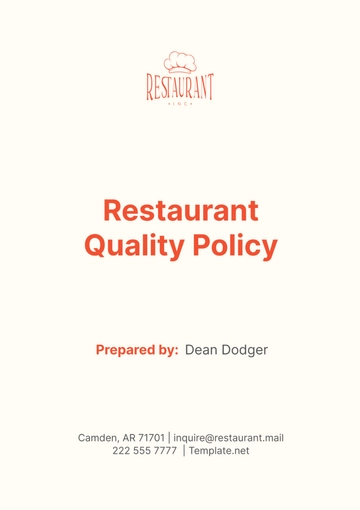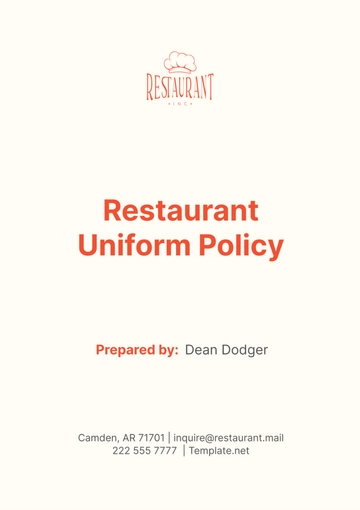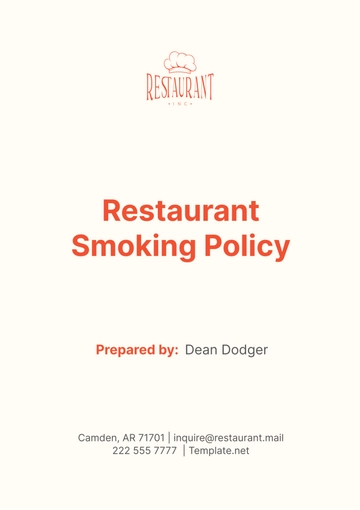Free Restaurant Order Policy
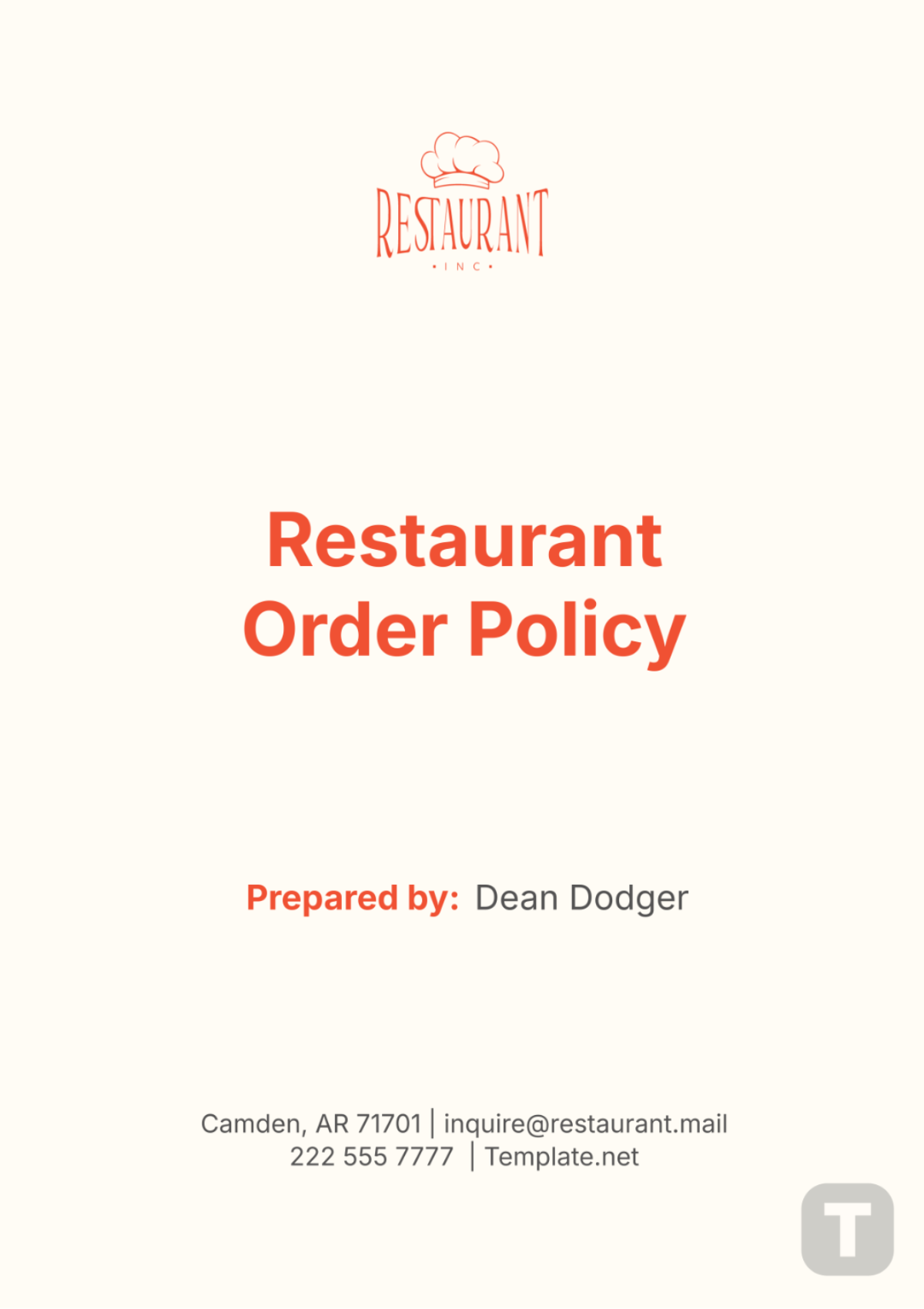
Effective Date: [Month Day, Year]
The Restaurant Order Policy at [Your Company Name] is designed to streamline the ordering process, ensuring accuracy and efficiency in handling customer orders. This policy outlines the procedures for taking, confirming, and fulfilling orders, whether placed in-person, over the phone, or through online platforms. It applies to all staff involved in the order process, including servers, kitchen staff, and delivery personnel, to maintain consistency and reduce errors.
The scope of the policy also includes guidelines on handling special requests, dietary restrictions, and modifications to ensure customer satisfaction and compliance with health standards. Moreover, the policy details the protocols for order discrepancies and resolutions, enhancing the overall dining experience by prioritizing clear communication and prompt service.
1. Order Taking Procedures
At [Your Company Name], our Order Policy is designed to ensure efficient, accurate, and seamless handling of customer orders across all channels. By standardizing order-taking procedures for in-person, phone, and online orders, we aim to enhance the customer experience, minimize errors, and maintain high service standards. This policy provides clear guidelines for staff to follow, ensuring every order is executed with precision and professionalism.
1.1 In-Person Orders: Servers must greet customers promptly, provide menus, and clearly explain any specials. Orders should be taken using a standardized order form or a digital device to ensure legibility and accuracy.
1.2 Phone Orders: Staff answering the phone should clearly state the restaurant’s name and identify themselves. All details of the order, including spelling of names, contact numbers, and any special instructions, must be confirmed and repeated to the customer before finalizing the order.
1.3 Online Orders: The online ordering platform should be user-friendly and updated regularly. After an online order is received, an automatic confirmation email or text message should be sent to the customer. Additionally, the order must be promptly reviewed by staff for accuracy.
2. Order Confirmation
At [Your Company Name], our Order Confirmation procedures are vital for ensuring every customer's order is correct and delivered promptly. By implementing clear confirmation practices for in-person, phone, and online orders, we aim to reduce errors, enhance customer satisfaction, and maintain high operational standards. This section outlines the steps staff must follow to verify and confirm orders, ensuring a seamless and accurate ordering experience.
2.1 In-Person Confirmation: Repeat the order back to the customer to ensure all details are correct. Provide an estimated time for when the order will be ready.
2.2 Phone Confirmation: Upon completion of taking an order over the phone, repeat the entire order to the customer to confirm accuracy. Provide an estimated delivery or pickup time.
2.3 Online Confirmation: Orders placed online will receive an automatic confirmation. Staff should also personally review and confirm the order as an extra layer of accuracy.
3. Fulfilling Orders
At [Your Company Name], our Fulfilling Orders procedures are designed to guarantee that every order, whether for delivery or pickup, meets our high standards for quality and accuracy. By following these detailed guidelines, our staff can ensure that all orders are properly prepared, packaged, and delivered to our customers in a timely and professional manner. This section outlines the steps required to fulfill delivery and pickup orders, enhancing customer satisfaction and operational efficiency.
3.1 Delivery Orders: Ensure that all items are properly packed and that any special requests or modifications are clearly labeled. Delivery personnel should double-check the order against the receipt before leaving.
3.2 Pickup Orders: Orders must be neatly packed and ready for pickup at the estimated time. Include the customer’s name and order details securely attached to the package.
4. Handling Special Requests and Modifications
Effectively handling special requests and modifications is crucial for providing an exceptional dining experience. Staff must be well-trained to understand and accommodate various dietary restrictions, allergies, and preferences. When requests cannot be fulfilled, it is imperative to communicate promptly with the customer, offering suitable alternatives whenever possible to ensure their satisfaction and safety.
4.1 Understanding Dietary Restrictions and Allergies
Understanding and accommodating dietary restrictions and allergies is crucial for providing a safe and enjoyable dining experience. By ensuring our staff are thoroughly trained and knowledgeable about menu ingredients, we can offer suitable alternatives and clearly communicate special dietary needs to the kitchen. This section outlines the essential steps for effectively managing dietary restrictions and allergies, emphasizing staff training, menu knowledge, and clear communication.
4.1.1 Training: Staff must undergo regular training on common dietary restrictions and food allergies.
4.1.2 Menu Knowledge: Staff should be well-versed in the ingredients of each menu item and able to suggest suitable alternatives.
4.1.3 Communication: Clearly mark any special dietary requests on the order to ensure kitchen staff are aware and can prepare accordingly.
4.2 Accommodating Preferences and Modifications
Accommodating customer preferences and modifications is key to providing a personalized and satisfactory dining experience. By allowing customization, accurately documenting modifications, and ensuring verification, we can meet individual customer needs while maintaining high standards of service. This section details the procedures for effectively managing order modifications, highlighting the importance of customization, precise documentation, and thorough verification.
4.2.1 Customization: Allow customers to customize their orders within the limits of what the kitchen can accommodate.
4.2.2 Documentation: Record all modifications accurately on the order ticket or digital system.
4.2.3 Verification: Double-check all modifications before serving the order to ensure accuracy.
4.3 Communicating Unfulfilled Requests
Effectively communicating unfulfilled requests is crucial for maintaining customer trust and satisfaction. Prompt notification, offering suitable alternatives, and ensuring the customer feels valued are key components of this process. This section outlines the steps for managing unfulfilled requests, emphasizing timely communication, proposing alternatives, and prioritizing customer satisfaction.
4.3.1 Timely Notification: Inform the customer immediately if a request cannot be fulfilled.
4.3.2 Alternatives: Offer alternative options that closely match the customer’s original request.
4.3.3 Customer Satisfaction: Ensure the customer feels heard and valued, and make every effort to meet their needs within the restaurant's capabilities.
5. Managing Order Discrepancies
Handling order discrepancies efficiently is vital for maintaining customer trust and satisfaction. Staff must immediately address any issues, identify the cause, and offer a suitable resolution. Documenting these incidents is essential for future reference and training, helping prevent similar issues.
5.1 Immediate Response
Providing an immediate response to order discrepancies is essential for maintaining customer satisfaction and trust. Prompt acknowledgment, a sincere apology, and proposing a suitable solution are key steps in this process. This section outlines the procedures for addressing order discrepancies, emphasizing the importance of quick recognition, effective communication, and appropriate resolution.
5.1.1 Acknowledgment: Recognize the discrepancy as soon as it is identified.
5.1.2 Apology: Offer a sincere apology to the customer for any inconvenience caused.
5.1.3 Solution: Propose a suitable solution, such as a replacement, discount, or refund.
5.2 Identifying the Cause
Identifying the cause of order discrepancies is crucial for preventing future occurrences and maintaining high service standards. Through thorough investigation, involving relevant staff, and implementing preventative measures, we aim to address and mitigate issues effectively. This section details the steps required to identify the root cause of discrepancies, emphasizing investigation, staff involvement, and proactive solutions.
5.2.1 Investigation: Determine how the discrepancy occurred by reviewing the order details and preparation process.
5.2.2 Staff Involvement: Engage the relevant staff members to understand their perspective and gather all necessary information.
5.2.3 Preventative Measures: Identify steps to prevent similar issues in the future.
5.3 Documentation and Follow-Up
Documenting and following up on order discrepancies is essential for continuous improvement and customer satisfaction. By maintaining detailed records, utilizing cases for staff training, and seeking customer feedback, we ensure issues are addressed comprehensively. This section outlines the procedures for effective documentation and follow-up, emphasizing record keeping, training, and customer communication.
5.3.1 Record Keeping: Document the discrepancy, including the cause and resolution, in a dedicated log.
5.3.2 Training: Use the documented cases for staff training sessions to highlight common issues and effective solutions.
5.3.3 Customer Feedback: Follow up with the customer to ensure they are satisfied with the resolution and to gather any additional feedback.
6. Compliance and Training
Ensuring all staff are well-trained and compliant with the Restaurant Order Policy is essential for maintaining consistent service quality. Comprehensive training programs and regular updates keep staff informed and skilled in all procedures, fostering a professional and efficient team.
6.1 Comprehensive Training
Comprehensive training is fundamental to ensuring that all staff are well-versed in the Restaurant Order Policy and procedures. Through initial training, ongoing education, and regular assessments, we aim to equip our team with the knowledge and skills necessary to maintain high service standards. This section details our comprehensive training approach, emphasizing thorough onboarding, continuous learning, and effective assessment.
6.1.1 Initial Training: Provide new hires with thorough training on the Restaurant Order Policy and procedures.
6.1.2 Ongoing Education: Offer regular training sessions to reinforce knowledge and introduce new practices.
6.1.3 Assessment: Conduct assessments to ensure staff understand and can apply the procedures effectively.
6.2 Regular Reviews and Updates
Regular reviews and updates of the Restaurant Order Policy are essential for maintaining its relevance and effectiveness. By consistently updating the policy, conducting staff briefings, and integrating feedback, we ensure that our procedures remain current and practical. This section outlines the steps for keeping the policy updated, highlighting the importance of continuous improvement and staff involvement.
6.2.1 Policy Updates: Keep the Restaurant Order Policy current with regular reviews and necessary updates.
6.2.2 Staff Briefings: Inform staff of any changes or improvements to the process through scheduled briefings.
6.2.3 Feedback Integration: Incorporate staff feedback into policy updates to address practical challenges and improve procedures.
6.3 Monitoring Compliance
Monitoring compliance with the Restaurant Order Policy is crucial for maintaining high standards of service. Through regular observation, creating a feedback loop, and incorporating compliance into performance reviews, we ensure that all staff adhere to established procedures. This section outlines our approach to monitoring compliance, emphasizing observation, feedback, and continuous improvement.
6.3.1 Observation: Regularly observe staff to ensure adherence to the policies and procedures.
6.3.2 Feedback Loop: Create a feedback loop where staff can report any difficulties or suggest improvements.
6.3.3 Performance Reviews: Include compliance with order policies in performance reviews to emphasize its importance and encourage continuous improvement.
7. Contact Information
If you have any questions or need further clarification regarding this policy, please contact us:
Email: [Your Company Email]
Phone: [Your Company Number]
This integrated approach will create a compelling narrative that enhances and embodies the brand's unique identity.
- 100% Customizable, free editor
- Access 1 Million+ Templates, photo’s & graphics
- Download or share as a template
- Click and replace photos, graphics, text, backgrounds
- Resize, crop, AI write & more
- Access advanced editor
Optimize your restaurant operations with our Restaurant Order Policy Template from Template.net. This fully editable and customizable document provides clear guidelines for order management. Easily editable in our AI Editor Tool, creating a tailored order policy has never been simpler. Elevate efficiency and professionalism in your establishment. Download today to streamline processes and impress your clientele!
You may also like
- HR Policy
- Restaurant Policy
- Company Policy
- Accounting Policies and Procedures
- Website Policy
- Privacy Policy
- Safety Policy
- School Policy
- IT and Software Policy
- Law Firm Policy
- Construction Policy
- Interior Design Policy
- Travel Agency Policy
- Education Academic Policy
- Security Policy
- Real Estate Policy
- Expense Policy
- Software Policy
